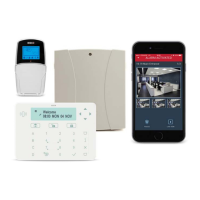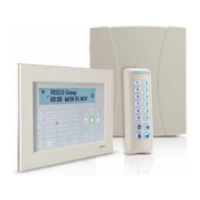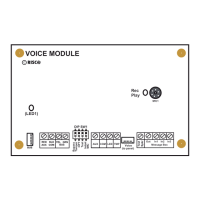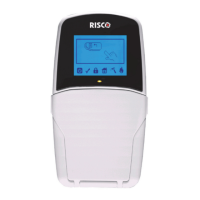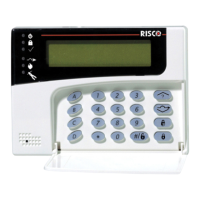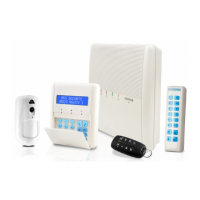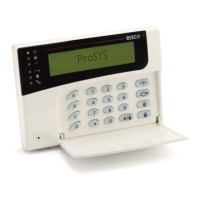




Do you have a question about the Risco LightSYS and is the answer not in the manual?
Details the primary features and capacity of the LightSYS security system, including sensor limits, user codes, partitions, and outputs.
Explains the system's architecture and components, including wired detectors, wireless, RISCO Bus, GSM/GPRS, IP/Internet, and PSTN/Dial Up connections.
Describes the various methods users can operate the LightSYS, including keypads, keyfobs, remote phone operation, SMS, and configuration software.
Explains how the system reports events to an Alarm Receiving Center and the 'Follow Me Messaging' feature for SMS or email notifications.
Details the meaning of various LCD icons and status indicators on the LightSYS keypad for system status and faults.
Describes the audible annunciation sounds produced by the system for various events like alarms, entry/exit delays, and setting/unsetting.
Guides users on how to arm the security system, covering user code entry, quick setting, and prerequisites before setting.
Explains the procedure for fully arming the system when leaving the premises, including exit delay and confirmation.
Details how to partially arm the system, allowing individuals to remain inside while perimeter detectors are active.
Describes how to set and unset individual partitions within the system, allowing for segmented security management.
Guides users on how to disarm the security system, covering full unsetting, partition unsetting, and entry delay.
Details the steps to unset the system after an alarm has occurred, including identifying the cause and resetting the system.
Describes the use of a special duress code to silently trigger an alarm while unsetting the system, ensuring user safety.
Details the keypad functions for police, fire, and auxiliary emergency alarms, including activation and system notification.
Explains the role of user codes, their length, authority levels, and the system's support for multiple codes.
Defines different authority levels (Grand Master, Master, User, etc.) and their associated permissions and system access.
Provides step-by-step instructions for setting new user codes or modifying existing ones, requiring appropriate authority.
Describes how proximity key tags can be used for system set/unset operations and controlling home appliances.
Explains how to temporarily or permanently omit zones from the system to allow access or bypass faulty zones.
Details how to automate system operations like setting, unsetting, and PO activation using weekly time schedules.
Covers system testing procedures like walk tests, keypad tests, and sounder tests for ongoing maintenance.
Details the primary features and capacity of the LightSYS security system, including sensor limits, user codes, partitions, and outputs.
Explains the system's architecture and components, including wired detectors, wireless, RISCO Bus, GSM/GPRS, IP/Internet, and PSTN/Dial Up connections.
Describes the various methods users can operate the LightSYS, including keypads, keyfobs, remote phone operation, SMS, and configuration software.
Explains how the system reports events to an Alarm Receiving Center and the 'Follow Me Messaging' feature for SMS or email notifications.
Details the meaning of various LCD icons and status indicators on the LightSYS keypad for system status and faults.
Describes the audible annunciation sounds produced by the system for various events like alarms, entry/exit delays, and setting/unsetting.
Guides users on how to arm the security system, covering user code entry, quick setting, and prerequisites before setting.
Explains the procedure for fully arming the system when leaving the premises, including exit delay and confirmation.
Details how to partially arm the system, allowing individuals to remain inside while perimeter detectors are active.
Describes how to set and unset individual partitions within the system, allowing for segmented security management.
Guides users on how to disarm the security system, covering full unsetting, partition unsetting, and entry delay.
Details the steps to unset the system after an alarm has occurred, including identifying the cause and resetting the system.
Describes the use of a special duress code to silently trigger an alarm while unsetting the system, ensuring user safety.
Details the keypad functions for police, fire, and auxiliary emergency alarms, including activation and system notification.
Explains the role of user codes, their length, authority levels, and the system's support for multiple codes.
Defines different authority levels (Grand Master, Master, User, etc.) and their associated permissions and system access.
Provides step-by-step instructions for setting new user codes or modifying existing ones, requiring appropriate authority.
Describes how proximity key tags can be used for system set/unset operations and controlling home appliances.
Explains how to temporarily or permanently omit zones from the system to allow access or bypass faulty zones.
Details how to automate system operations like setting, unsetting, and PO activation using weekly time schedules.
Covers system testing procedures like walk tests, keypad tests, and sounder tests for ongoing maintenance.
| Remote Configuration | Yes |
|---|---|
| Mobile App | Yes |
| Type | Hybrid (wired and wireless) |
| Remote Control | Yes |
| Siren Output | Yes |
| Event Log | 500 |
| Communication | IP, GSM, PSTN |
| Wireless Frequency | 868 MHz |
| Backup Battery | 12V 7Ah battery |
| Partitions | 4 partitions |
